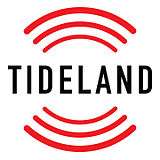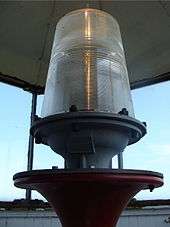Tideland Signal
 | |
| Private | |
| Founded | 1954 |
| Headquarters | Houston, Texas, United States |
Key people | Matt Scheuing (CEO)[1] |
| Products | Navigational aids |
| Owner | Xylem, Inc |
| Website |
www |
Tideland Signal, sometimes referred to as Tidelands,[2] is a privately held, Houston, Texas based manufacturer of marine navigational aids, with main offices in Lafayette, Louisiana, Vancouver, Canada, Burgess Hill, UK, Dubai, United Arab Emirates and Singapore.[3] It is the manufacturer of the ML-300 lantern, widely used in lighthouses around the world for more than 50 years. In 2016, Tideland was acquired by Xylem, Inc.
History
Tideland Signal was founded by several salesman of Automatic Power, a battery manufacturer which was then a primary player in the buoy market.[4] The company originally sold directly to Automatic's market, but with limited success.
During the 1960s, solar cells had started to become practical systems for recharging batteries in remote locations. Hoffman Electronics, a pioneer in solar power, had approached Automatic with the idea of placing panels on their buoys to reduce the number of battery replacements needed to keep a site operations. Automatic instead saw this as a serious threat to their business, so they purchased the Hoffman concept and buried it.[4]
Shortly thereafter, a research division of Exxon was in the process of introducing their own solar panels. Examining the market, they saw that Tideland was struggling with 30% market share, and approached them. Tideland took up development, introducing a buoy with rechargeable batteries and a solar panel. It was an immediate success, and the company soon eclipsed Automatic.[4] By the late 1970s the solar-powered buoy was widely used.
In 1965 Tideland introduced the world first transistorized automatic lamp changer. In 1967 Tideland introduced a 300 millimetres (12 in) acrylic Fresnel lens lantern, the ML-300, which is still widely used.[5]

Tideland ML-300
The Tideland ML-300 (ML for MaxLumina) is a multi-purpose marine lantern, with a focal length of 300 millimetres (12 in). It consists of a single piece injection molding acrylic 300mm Fresnel lens and a base assembly, where a flasher or lamp changer can be installed. The light produced is a 360° omnidirectional beam and colored signatures are achieved by colored inserts.[2] It has a range of more than 10 nautical miles (19 km; 12 mi).[6]

Since its introduction in 1967, The ML-300 is in wide use all around the world. It is in wide use in the Great Lakes region as a medium-range lens.[2] It is also in use in Australia by the Australian Maritime Safety Authority, for example in Dent Island Light[7] and Bugatti Reef Light,[8] both in Queensland.
Other products
In 2010, Tideland Signal provided SB‐30 lateral marker buoys and three DM‐390 buoys for use during the Vancouver Winter Olympics.[9]
References
- ↑ "Who is Tideland". tidelandsignal.com. Retrieved July 29, 2014.
- 1 2 3 Terry Pepper (2007-02-12). "Seeing The Light - The 300mm plastic lighthouse optic.". terrypepper.com. Retrieved February 8, 2011.
- ↑ "Contact Us". tidelandsignal.com. Retrieved February 8, 2011.
- 1 2 3 John Perlin (2002). From Space to Earth: The Story of Solar Electricity. Harvard University Press. pp. 60–61.
- ↑ "Company Profile". tidelandsignal.com. Retrieved February 8, 2011.
- ↑ "Incandescent Lanterns". tidelandsignal.com. Retrieved February 8, 2011.
- ↑ "Dent Island Light, QLD, AN362-01" (PDF). Aids to Navigation Schedule Issue 11. Australian Maritime Safety Authority. September 2004.
- ↑ "Dent Island Light, QLD, AN490-01" (PDF). Aids to Navigation Schedule Issue 11. Australian Maritime Safety Authority. December 2006.
- ↑ "Tideland Signal Buoys Win Gold at the Vancouver 2010 Winter Olympics" (pdf). Tideland Signal Canada Ltd. Tideland Signal Corporation. February 2010. Retrieved February 6, 2011.